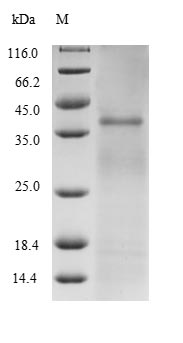Just like other recombinant proteins, the production of this recombinant M.tb fbpB protein began with appropriate cDNA and PCR methods, and then the fbpB expression plasmids were built. Following sequence determination of the constructs, plasmids were transformed into E.coli for the expression of the recombinant M.tb fbpB protein. N-terminal 6xHis tag was used in the process. And we finally get the protein of interest with purity of 85%+.
fbpB is a gene encoding a protein named Diacylglycerol acyltransferase/mycolyltransferase Ag85B in mycobacterium tuberculosis. This protein is also called 30 kDa extracellular protein, diacylglycerol acyltransferase, antigen 85 complex B (short name includes 85B and Ag85B), extracellular alpha-antigen and fibronectin-binding protein B (Fbps B). Ag85B is an immunogenic mycolyl transferase involved in the coupling of mycolic acids with arabinogalactan and is necessary for cell wall formation. An experiment has demonstrated that the production of IFN-gamma in the spleen cells increases in C57BL/6 mice subcutaneously immunized with recombinant fbpb protein.






